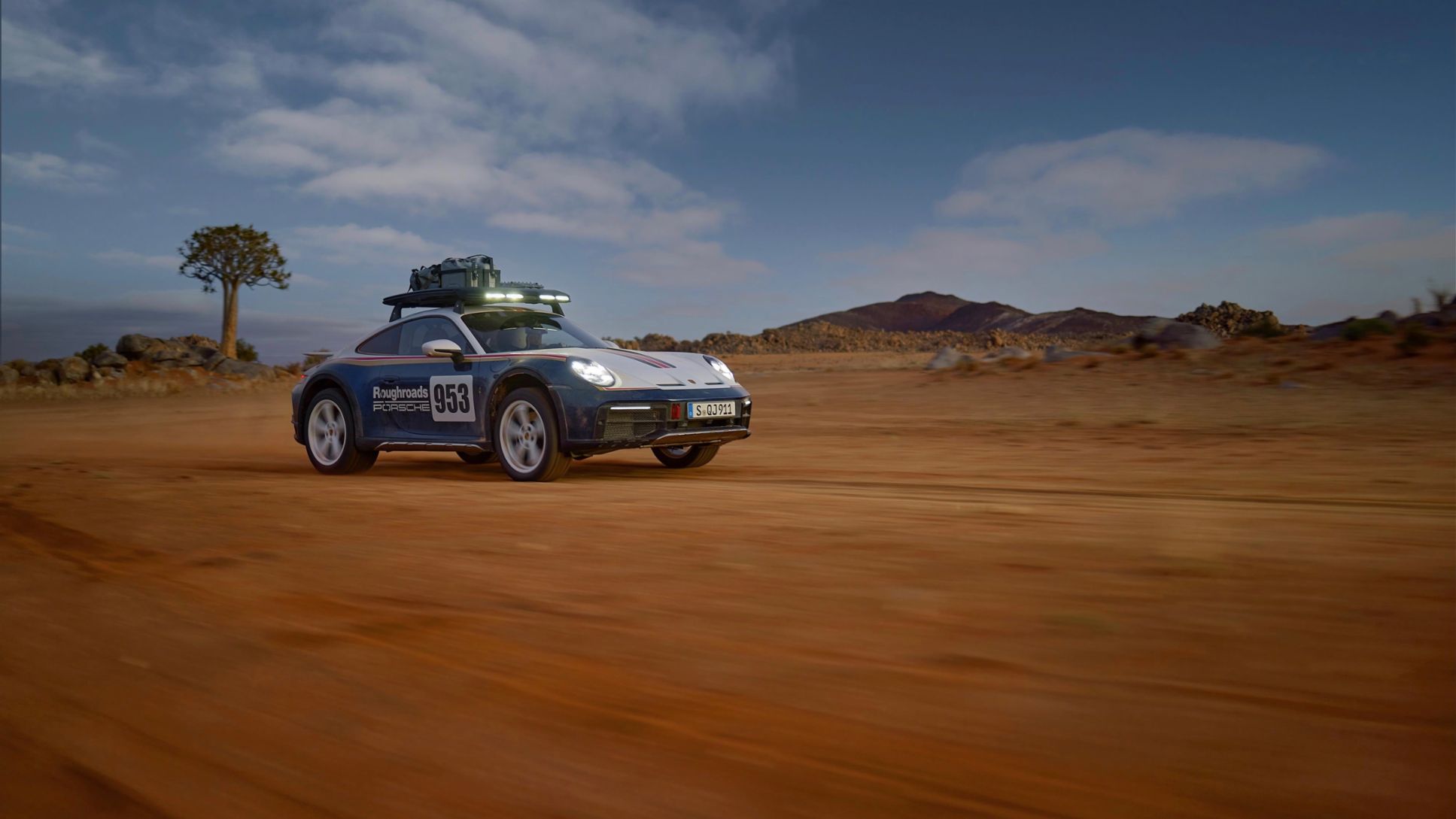The basic architecture of the 911 offers a good basis for off-road use that has been further optimised by making modifications to the body. The front overhang is 16 mm shorter, which together with the higher ground clearance increases the car’s approach angle, which has risen from eight to 16.1 degrees. The breakover angle is 19 degrees, making it comparable to the Cayenne or Macan.
Every component that distinguishes the 911 Dakar from other 911 models assumes an important role in the overall concept of the off-road sports car. The newly developed, fixed CFRP rear spoiler replaces the adjustable spoiler of the Carrera models in favour of greater robustness when exposed to large amounts of dirt and mud. It optimises the air flow to the intercoolers and increases downforce on the rear axle. This improves the lift balance – not least since the characteristic 911 front spoiler lip has been removed to improve the front slope angle. The wheel arch extensions made of impact-resistant black plastic take the increased track widths into account: the track has been widened by 28 mm at the front and 15 mm at the rear. The widened door sills and the lower edges of the newly designed front and rear aprons feature stone chip protection made from stainless steel sheeting. The protective grilles for the front side air intakes are also made of stainless steel. Red towing eyes made of forged aluminium are fixed elements at the front and rear.
Optional roof rack or roof tent as well as Porsche Design chronograph
The roof of the Porsche 911 Dakar features a visible 12-volt power outlet for the LED spotlights of the optional roof rack. With a capacity of 42 kg, the rack can accommodate typical off-road equipment such as fuel and water canisters, folding shovels and traction boards without any problems. A roof tent is also available for the 911 Dakar. Inside, the 911 Dakar underscores its sporting ambitions with standard full bucket seats and the omission of the rear seats. A defining feature of the Dakar’s interior is the standard Race-Tex surfaces with decorative stitching in Shade Green, which is also exclusively available as a metallic exterior finish for the 911 Dakar. The Rallye Sport Package with roll-over bar, six-point seat belts and fire extinguisher, is available as an option in most markets. Those who buy the 911 Dakar can exclusively order the Porsche Design Chronograph 1 ‒ 911 Dakar or the Chronograph 1 ‒ 911 Dakar Rallye Design Edition to match the vehicle. For the first time, the housing of these is made of particularly scratch-resistant and light titanium carbide.
Radiator with stone chip protection
In keeping with its specialised uses, the 911 Dakar has a modified cooling system that makes particular allowance for cooling requirements in off-road scenarios. The side cooling modules are equipped with stronger fans. The grilles were specially developed for the 911 Dakar and offer an ideal compromise between air throughput and stone chip protection.
With the increased ride height and extensive standard equipment with lift function, along with the high-quality PDCC chassis systems and rear-axle steering, the vehicle weight is higher than that of the Carrera 4 models. Engineers were able to largely counteract this added bulk by using lightweight construction measures. The 911 Dakar has no rear seats, for example, and the standard full bucket seats made of CFRP are also exceptionally light. Additional weight is saved by the use of a CFRP bonnet, CFRP rear spoiler, a lightweight battery and lightweight glass in the front, rear and front side windows. The movable cooling air flaps have also been removed for the off-road setup in the Dakar model. All in all, the empty Porsche 911 Dakar weighs in at 1,605 kg – just 10 kg more than the 911 Carrera 4 GTS with PDK, despite substantial extra equipment.
LED spotlights on the roof rack
A notable feature on the roof of the 911 Dakar is the new addition of an integrated power socket – a 12-volt connection that supplies the roof-mounted spotlights with power. This special roof rack is optional, though the roof power socket and the integrated securing system are standard features in the 911 Dakar. Use of the spotlights on the roof rack, which can be switched on using a button in the roof console, is only permitted when not driving on public roads.


